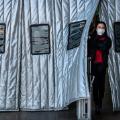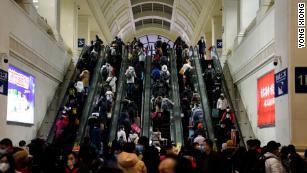A lot has changed since China's SARS outbreak 17 years ago. But some things haven't
In 2003, panic was setting in. The fatal severe respiratory syndrome (SARS) -- which first appeared in southern China -- had spread across borders, prompting schools to close in Singapore and hundreds to be quarantined in Hong Kong.
In the Chinese city of Wuhan, some 1,000 kilometers (620 miles) from the origin of the outbreak, Li -- then a 15-year-old high school student -- was cramming for exams.
Classes were running, but students were told they couldn't go home between their afternoon and evening classes, so parents clustered outside the school gate to pass boxes of food to their children.
Li, not his real name, said his school smelled of vinegar, due to a belief that vinegar fumes would help prevent the spread of disease.
CNN agreed to Li's request not to publish his name -- he's now an academic and fears any perceived criticism of the government could damage his career.
For Li, SARS didn't feel like something he was going to catch himself.
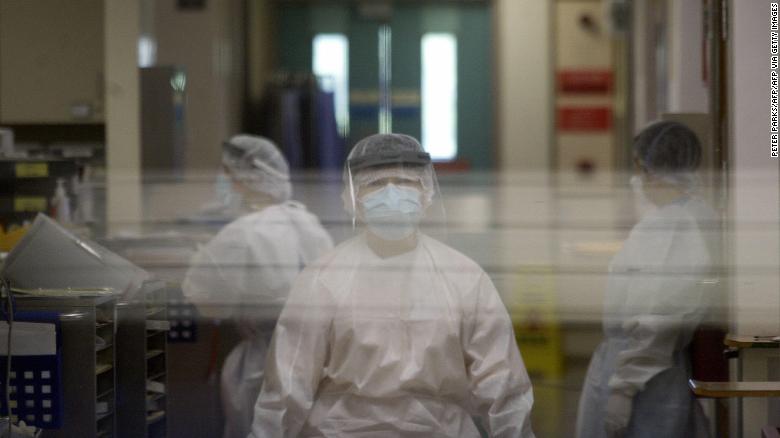
Medical staff wearing protective gear go about their duties in the Alice Ho Miu Ling Nethersole Hospital in Hong Kong after seven hospital workers reported flu-like symptoms on August 27, 2003.
Back then, there were no high-speed trains linking Wuhan with other cities, and the southern province of Guangdong, where the outbreak started, felt very far away. Some people wore masks, others didn't.
Almost two decades later, Asia is on the brink of another pandemic, say experts. For many, it feels eerily similar to the SARS outbreak that infected over 8,000 people and killed 774 around the world between November 2002 and July 2003. SARS is also a type of coronavirus, which causes flu-like symptoms, and can mutate as it spreads from person to person.
In the past month, at least 41 people have died and more than a thousand people have been diagnosed as infected by the Wuhan coronavirus, a cousin of SARS. Cases have been reported in a number of countries, including the United States, France, and Singapore.
Transport is on lockdown in Wuhan -- a city of 11 million and the epicenter of the virus -- and in 10 nearby cities. This is all happening at the worst possible time of year: Lunar New Year, the most significant holiday in the Chinese calendar, when three billion trips were expected to be made.
Even before Wuhan closed train stations and airports, Li -- who is now 31 and working in Macao -- decided, for the first time in his adult life, not to go home for Lunar New Year, which is also known in the mainland as Spring Festival. He worries for his family's health, but says there's little he personally can do.
"I would hope the government learned a lesson from what happened 17 years ago," said Li. "It seems like they are taking the issue seriously, but I am not sure if it is a little bit too late."
Six weeks into the outbreak, there are signs that China is handling this outbreak differently. But there's still concern over China's response -- and just how transparent Beijing is being.
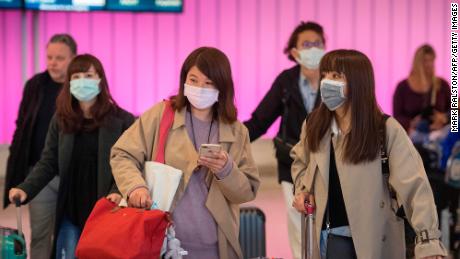
What do you need to know about Coronavirus?
What went wrong during SARS
In the first few months of the 2003 SARS outbreak, China kept the disease under wraps.
SARS was first publicly reported in February 2003, but by that time the country was already months into an outbreak. Five people had died and another 300 had fallen ill from the disease in Guangdong province.
In April 2003, a prominent doctor in Beijing went on the record to accuse the government of a cover-up. Later that month, China sacked its health minister and the mayor of Beijing over their mishandling of the outbreak.
And it wasn't until April -- around five months after the outbreak started -- that American and Canadian scientists announced they had sequenced the genome thought to be the cause of the SARS virus.

Screening measures for the new coronavirus at Hong Kong International Airport on January 23, 2020.
The lack of transparency from China, combined with a lack of knowledge about what the virus was and a lack of preparedness among countries in the region in dealing with pandemics, all contributed to SARS's deadly impact.
In semi-autonomous Hong Kong, over 280 people died from SARS -- the highest proportion of death per capita of any territory in the world.
"The outbreak was very, very difficult to control. At that time, we had no idea what caused the pandemic," said Ivan Hung, a specialist in infectious disease at Hong Kong University. "We were not able to get on top of things and able to make early diagnosis and isolation as a result. There was a lot of cross infection that happened in the hospital."
A visual guide to the Wuhan coronavirus
SARS also exposed how ill-prepared China and other territories were at responding to pandemics. In a paper published soon after the epidemic was contained, Hong Kong's former Director of Health Lee Shiu-hung pointed to a number of issues facing the city, including a lack of protective clothing for medical staff, ill-prepared hospital authorities, and basic failings in the healthcare system, like overcrowded wards and poor ventilation.
As Hung puts it, last time around, public health authorities were "playing catch up."
Grace -- a 37-year-old Hong Konger -- was interning at a hotel at the time, and remembers the fear. At her hotel, everyone wore a mask, and people cleaned their hands and phones before starting work.
"Everyone was worried because nobody knew how serious it was. Everybody had to wear masks wherever they go. Business was not good as well," said Grace, who asked CNN not to use her last name out of concern for the impact of her current job. "People preferred to stay at home if they didn't have to go to work or school."
A different China
In the six weeks since the first case of Wuhan coronavirus was detected, it's already clear that today's China isn't the same as the China of 2003.
China informed the World Health Organization about the new virus on December 31, 2019, less than three weeks after the first case was detected on December 12. The virus behind the outbreak was identified on January 7 -- as swift as any other developed country would have been able to identify it, said Ian Lipkin, a professor of epidemiology at Columbia University who worked to contain SARS back in 2003.
The prompt identification of the new strain allowed other countries to develop tests for the virus early on that should help contain the outbreak, said Peter Daszak, the president of non-profit EcoHealth Alliance, which researches emerging infectious diseases.
Experts have also praised China for being transparent about the outbreak -- something the country was criticized for last time. Many are also impressed with China's unprecedented decision this week to stop transport to and from Wuhan during the country's biggest holiday. "SARS was a huge embarrassment to China, and that's been driving a lot of the openness and transparency around this outbreak," Daszak said.
There are other things, too, that should make this outbreak easier to contain than SARS 17 years ago.
China and other Asian countries have stepped up their ability to respond to pandemics. Chinese residents are also more aware of how to protect themselves from the spread of disease, Lipkin said. Face masks are now mandatory in Wuhan, but before that, online sales surged, China Daily reported.
Wuhan coronavirus virus spreads as China scraps New Year celebrations
That's also true in Hong Kong. For almost eight months, face masks have been closely associated with the ongoing pro-democracy protest movement. But over the past few weeks, more and more people have been wearing surgical masks in public -- for health reasons. For many, SARS taught them how to respond to the risk of disease.
Surgical masks are now ubiquitous on the subway, and Hong Kong is facing a serious shortage of face masks, according to Horace Lau, the vice president of Hong Kong's General Chamber of Pharmacy.
Grace said she started wearing a mask weeks ago.
"Since SARS took place in 2003, people in Hong Kong are more conscious about health and how to protect themselves," she said.
What hasn't changed
But while China has undoubtedly been more communicative about the Wuhan coronavirus, there's still lingering distrust.
In 2003, then 15-year-old Li didn't think to question the authorities. Now, as an academic living outside mainland China's censorship, Li believes the Chinese government doesn't trust its people to handle the full truth.
"(It's this) sort of idea of 'we have to control the scale of the panic instead of the scale of disease," he said. "I can only hope that ... they can act better and they can respond quickly instead of keeping people in the dark."
On Wednesday, a senior US State Department official said the US was concerned about the Chinese government's transparency.

Social media videos appear to show patients overcrowd hospitals
"I do believe that the concern you see both inside China and internationally is a reflection of what we've seen in the past," the official said. "That reluctance to respond in a rapid manner doesn't give the global community a secure feeling for this being managed inside China."
However, on Friday President Donald Trump said on Twitter that China "had been working very hard to contain the Coronavirus" and thanked Chinese President Xi Jinping.
"The United States greatly appreciates their efforts and transparency. It will all work out well. In particular, on behalf of the American People, I want to thank President Xi!" Trump tweeted.
Last weekend, Imperial College London found that an estimated 1,723 people were likely to have been infected by the virus by January 12, significantly more than the 45 confirmed cases around the time the study was released. On Monday, Chinese authorities reported that the number of cases had tripled over the weekend to 218.
Those figures worried some people, but Daszak points out that there are always going to be more people infected than we know about -- not everyone's symptoms are serious enough for them to seek medical attention. Lipkin agrees, saying that authorities are likely being cautious about reporting numbers as it is winter -- a season when people often get flu and pneumonia anyway.
Wuhan is the latest crisis to face China's Xi, and it's exposing major flaws in his model of control
Online, numerous people claim to have been turned away from Wuhan's hospitals. Although CNN has not been able to verify individual claims, Wuhan's health authority acknowledged in a statement that local hospitals were overwhelmed. Officials said the situation would improve as more medical facilities were set aside for the detection and treatment of the virus. According to state media reports, Wuhan plans to build a new hospital in six days.
There's also more to be done to address a major issue: live animal markets.
The coronavirus that caused SARS was traced to the civet cat, a wild animal considered a delicacy in parts of south China. After the outbreak in 2003, China banned the slaughter and consumption of civet cats.
This time around, it's believed the Wuhan coronavirus outbreak started in the now-shuttered Wuhan Huanan Wholesale Seafood Market, where a number of wild animals were for sale, including raccoon dogs and snakes. Experts believe that the coronavirus was carried by animals -- possibly snakes -- and then spread to humans.

Residents wear masks to buy vegetables at a market in Wuhan on January 23, 2020.
Although China bans the trafficking of some wild animals, it is still widely seen as the world's largest market for illicit wildlife products. Experts say markets that sell wild animals need to be banned.
"It places the whole world at risk. And I don't think we can allow these to continue. The risk is just too great," Lipkin said.
Daszak added that countries need to take more preventative measures to stop pandemics.
"We should treat pandemics a bit like smoking or heart disease," he said. "We spend billions of dollars once they emerge to control an outbreak, but we should also start spending money before they emerge to stop them spilling over to people."
Is this SARS all over again?
There's reason to think that the current coronavirus outbreak won't have the same impact as SARS did in 2003.
For now, the virus doesn't seem as deadly. As of Thursday, Daszak estimated that it had a 3.5% mortality rate -- the WHO estimates that SARS had a fatality ratio of 14% to 15%.
This time around, we know what the disease is, and there are potential vaccines that can be trialed, Daszak said. Health authorities are also better prepared, says Hung, who doesn't think that this outbreak will be as bad as SARS.
But authorities also face new difficulties. This outbreak coincides with the Lunar New Year, and in the past 17 years, China has seen a dramatic increase in international and domestic travel.
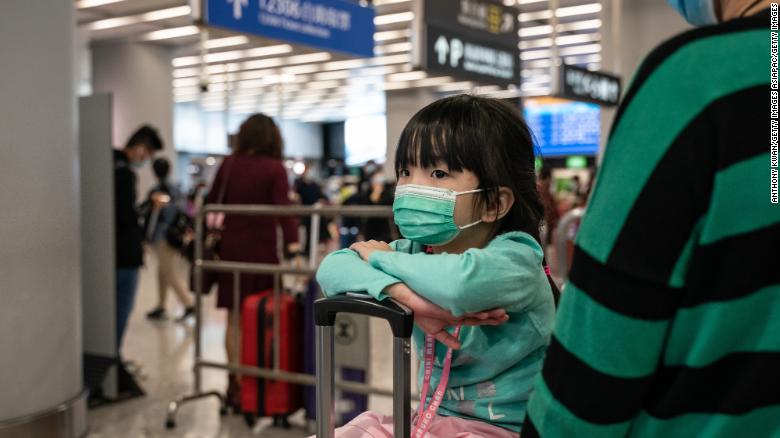
Travelers wearing face masks wait at the departure hall at West Kowloon Station on January 23, 2020 in Hong Kong.
China's expansive trade network means the virus could spread to places like Africa, where testing might not be so intensive, Daszak said. Even in more developed countries, identifying people who were potentially infected still largely depends on them self-reporting their symptoms -- something some people just won't do.
At the moment, the disease hasn't become a super-spreader like SARS. If a disease is a super-spreader, it means that one person infects many people. There has been one report of a single patient infecting 14 health care workers, but no other similar cases have been reported.
But if the virus evolves to become a super-spreader, Daszak said that would "basically be a repeat of SARS."
"It's beginning to look more and more like SARS every day," Daszak said, adding that the decision to shut down Wuhan suggested the authorities know something about the way the disease spreads that isn't good news.
Whether this epidemic turns into SARS or not depends on how the disease evolves -- and how well public health authorities manage to contain it, he said.
"Right now, we are on the cusp of what could be a repeat of the SARS pandemic.
News Courtesy: www.cnn.com

